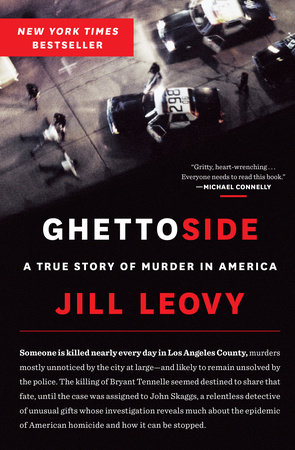Ghettoside Summary

6 min read ⌚
 A True Story of Murder in America
A True Story of Murder in America
“Someone is killed nearly every day in Los Angeles County,” reminds us Jill Leovy. And practically nobody is doing anything about it. Because it’s usually blacks killing blacks.
“Ghettoside” is about one guy, John Skaggs, who did many things when another one, Bryant Tennelle, was senselessly murdered. And about how his actions can teach us what can be done in the future and what hasn’t been done in the past.
Who Should Read “Ghettoside”? And Why?
As its blurb states pinpointedly, “Ghettoside” is a “masterly work of literary journalism about a senseless murder, a relentless detective, and the great plague of homicide in America.” But, it’s also so much more – it’s a story about the forgotten ones and about the reasons why we forgot them.
People who want to understand the reasons behind this are welcomed to read “Ghettoside.” Those who have developed a prejudice against black communities based on their homicide rates should make this book a priority read. Finally, supporters of police reforms will find here few essential arguments to use in future discussions.
About Jill Leovy
Jill Leovy is an American journalist and editor.
is an American journalist and editor.
She worked for “The Los Angeles Times” from 1993 to 2017, covering all kinds of topics before becoming a crime correspondent in 2002. Most recently, she wrote about cybersecurity and related subjects.
“Ghettoside” was published in 2015. It is Leovy’s only book so far.
“Ghettoside Summary”
Here how the story originally went:
“Bryant Tennelle, 18, a young black man, was shot in the head in front of 1858 W. 80th St. near St. Andrews Street in Los Angeles. The assailant walked up to Bryant and shot him. He was taken to a hospital, where he died at 9:30 p.m. Friday, May 11.”
After murdering Tennelle, the assailant ran down the street, jumped into an SUV, and vanished. According to Jill Leovy, there was a high chance that would have been the end of the story.
The reason?
It was a “ghettoside” murder, one of thousands and thousands of similar offenses of a young black man killing another. And, Leovy claims, as far as the American police forces are concerned, “ghettoside” murders are all about statistics; as if they have nothing to do with heartbroken mothers and grief-stricken sisters.
Tennelle’s murder, fortunately, was not about to go down that easily. Especially not with John Skaggs, an LAPD detective who went far and wide to find the perpetrators. Finally, he did, so the Homicide Report was able to put the story to rest:
“Update: This case has been solved. A 25-year-old black man and a 16-year-old black youth have been arrested and charged with the murder of Bryant Tennelle. They probably had no idea they were killing the son of a police officer. They both face trial. The arrests were the work of LAPD South Bureau Det. John Skaggs.”
And no, John Skaggs wasn’t Bryant’s father. However, Lyone claims, “if every murder and every serious assault against a black man on the streets were investigated with Skaggs’s ceaseless vigor and determination – investigated as if one’s own child were the victim, or as if we, as a society, could not bear to lose these people – conditions would have been different.”
What conditions?
Well, those in the ghettos, about which Elvis Presley tearjerkingly sang back in 1969. It was a song about the cycle of poverty and violence some people can’t get out of. Half a century later, we have learned nothing from that song, have we?
Because if you remember the analysis in “Freakonomics,” unlike white communities, black still have the same severe problems with crime. Jill Leovy provides the shocking numbers.
Namely, even though black people form just 6% of the overall population in LA, 1 in 2 homicide victims is a black man. Which, in other words, means that on every 35 black men living in Los Angeles, 1 will probably end up murdered!
That’s stats for you right there.
Frightening, horrible, accurate stats!
But, what can we do about them?
Well, as Jill Leovy states herself, “Ghettoside” is a book with a straightforward premise. Namely, “where the criminal justice system fails to respond vigorously to violent injury and death, homicide becomes endemic.”
Or, as she likes to say borrowing a metaphor from Albert Camus, a plague.
What does this mean?
It means something Sudhir Venkatesh experienced on his own skin while living in the Chicago ghettos (ironically, the same Elvis sings about). Namely, that African American ghetto communities don’t trust the police, not because they are inherently bad, but because the police haven’t been doing their job the way John Skaggs had in the case of Bryant Tennelle.
So, in other words, gangs don’t cause lawlessness – they are its consequence.
Wait a minute, you may say! But, there are so many police patrols in the ghettos, and I’ve seen them confiscating marijuana and arresting petty thieves so many times!
But, that – that right there is the problem.
Wait… what?
They do that, alright. But they don’t solve murders. In fact, only 1 in 3 “ghettoside” murders ever get an epilogue. Which means that out of 100 murdered African Americans, about 70 lives are as important to us as squashed bugs.
You can see where we’re going with this, can’t you? And Leovy’s advice from above makes sense now, doesn’t it?
Solve the murders. Get their trust. Save many lives.
Key Lessons from “Ghettoside”
1. Nobody Cares About a Ghettoside Murder
2. Black Communities Have Their Own Justice Systems
3. “Gangs Are a Consequence of Lawlessness, Not a Cause”
Nobody Cares About a Ghettoside Murder
A white man kills a black man – that’s a hate crime. A black man kills a white man – now, that’s a serious cause for concern among all those peace-loving racists out there. A black man kills a black man – meh, it happens all the time.
We need to talk about that, says Jill Leovy. We need to talk about the injustice and find a way to repair it. Because it’s not merely injustice: it’s a plague.
And because, as the epigraph to “Ghettoside” says (borrowed from Albert Camus): “When you see the suffering and pain that it brings, you’d have to be blind, mad, or a coward to resign yourself to the plague.”
Black Communities Have Their Own Justice Systems
Ghettos have their own way of functioning. It’s a law within the law. But it’s not their own fault: it’s history’s.
Namely, you have to be aware that for the most of history, it was us (the whites) against them (the blacks). But it wasn’t a fair fight since us meant power and guns, and them meant no means for survival whatsoever. Now think about what a ghetto means in this context.
And why African Americans tell nothing even though they usually know everything about certain murders. To them, being a “snitch” still means betraying their own. Because they still believe in a higher law – the law of the ghetto and the street.
“Gangs Are a Consequence of Lawlessness, Not a Cause”
LAPD does very little to put an end to this. Because it punishes African Americans for smuggling marijuana, but it solves only 1 in 3 “ghettoside” murders. This results in an even more significant distrust for the police in these communities.
So, basically, they are lawless because no one bothers to implement the law in the first place. Our best chance of doing something about it: solving the unsolved murder cases.
Like this summary? We’d like to invite you to download our free 12 min app, for more amazing summaries and audiobooks.
“Ghettoside” Quotes
The system’s failure to catch killers effectively made black lives cheap. Share on X White people ‘had the law’... Black people didn’t. Formal law impinged on them only for purposes of control, not protection. Small crimes were crushed, big ones indulged—so long as the victims were black. Share on X Take a bunch of teenage boys from the whitest, safest suburb in America and plunk them down in a place where their friends are murdered and they are constantly attacked and threatened… Then see what happens. Share on X Before anything else, Bryant was black. To Devin Davis, that meant he was killable. Share on X When you see the suffering and pain that it brings, you’d have to be blind, mad, or a coward to resign yourself to the plague. (via Albert Camus) Share on XOur Critical Review
“Ghettoside” was a “New York Times” bestseller and named one of the ten best books of the year by numerous publications. It was also a finalist for “The National Book Critics Circle Award.”
In other words: it attracted the attention of the public, and the critics didn’t save any of their compliments and five-star ratings.
Moving and riveting, heart-wrenching and penetrating, “Ghettoside” is a book which deserves both.








